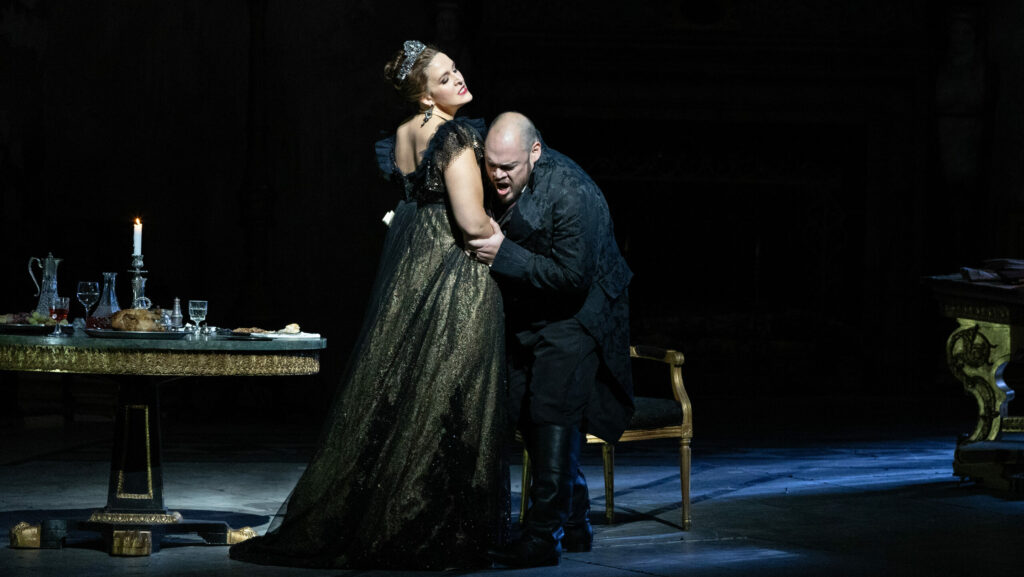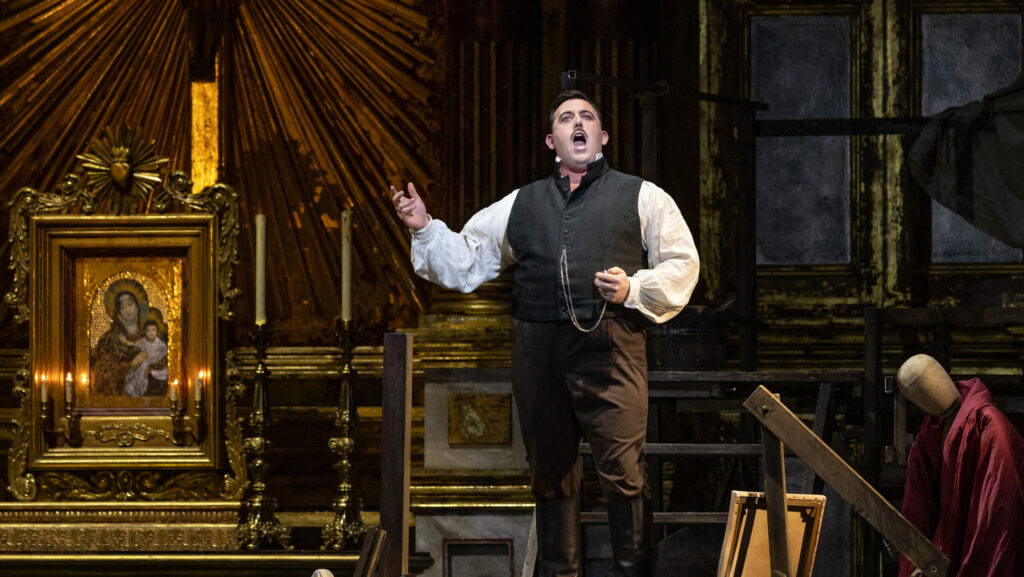The concept itself is sort of silly –what more can be done to heap laurels upon a composer whose operas already constitute around one out of every five of the company’s performances? And when we do fête Puccini, in this centenary of his death, what exactly are we celebrating?
In a short, jaunty documentary preceding the opera (“Puccini: A Historical Rhapsody”) that delved into Puccini’s involvement with the Met specifically, it was more what Puccini made possible, rather than the works themselves, that was the focus; the singers (including Enrico Caruso and Geraldine Farrar, “the Taylor Swift of her day,” according to narrator and Met historian Peter Clark), the celebrities, and, implicitly, the over 120 years of dependable box office receipts. The performance the followed provided little clarity; indeed, Tuesday night’s gala was a celebration of Puccini’s more unruly proliferations, his failsafe yet not quite justly ascribed reputation as a cheap thrills incubator, rather than the composer himself. The shocker may no longer be little, but it was especially shabby.
There was even something crass (albeit in a sort of vintage, quaint way) about the slapdash way the cast was put together; Decca exclusive superstars Lise Davidsen and Met debutant Freddie De Tommaso, like Mickey and Judy with barrel chests, jetted in last week to lead the cast, with a superb Quinn Kelsey singing his first complete Scarpia on this shore. The four-performance run will culminate in an HD broadcast on November 23 before the A-list stars once again scatter to the wind. It was a tenuous premise for such high stakes occasion and the performance laid those ingrained vulnerabilities bare.

Davidsen’s vulnerabilities, as it would seem from this performance, are primarily in the lower register. From her entrance into Sant’Andrea della Valle, chestless parlando lines failed to land – was I really having trouble hearing Lise Davidsen, of all people? The situation predictably persisted in Act II; while her high notes have a booming focus and a thrilling security, this highly professional and textually attentive singer was often subsumed by the orchestra the lower the role got. Lines which span octaves, like the thrice repeated “Che avvien?” when Scarpia hints at the horrors of Cavaradossi’s torture in Act II, made this fundamental low register weakness clear, as did Tosca’s in-alt agonized imprecations that were almost completely covered by the foreboding Dies Irae muttering of Tony Stevenson’s smarmy Spoletta.
Matters of timbral “fit” are of little interest or use to me, but the fact of the matter is that the role as yet remains unintegrated into Davidsen’s voice, which is a shame because the solidity and simultaneous warmth and brilliance of her top-heavy sound have an appealing, plainspoken drama in them, a plainspokenness that informs her largely pragmatic, unshowy, even demure characterization. This Tosca looked so deeply wounded by Cavaradossi’s painting of her romantic rival and her helplessness in the second Act was genuinely affecting. Some of this translated through to her poignant “Vissi d’arte,” where her high pianissimi were as much a thing of beauty as her blazing fortissimi elsewhere, but the first part of the aria looked and sounded like a sequence of mournful yawns as she knit the phrases together across an inconsistently developed lower/middle voice. And weaknesses like this occlude some of those declamatory moments that all Toscas surely relish – when “Ecco l’artista!” at Mario’s execution barely comes through, a discussion of interpretative priorities is probably warranted.
De Tommaso, on the other hand, seems to consider himself so perfect for his role that he has already lapsed into Caruso-stache’d caricature. The voice has a gravity and slightly covered depth with a grounded spin up top and breath control that allows for long and easy phrases, but the singing often turns vulgar. While the initial patchiness and coordination issues in “Recondita armonia” I initially credited to either nerves or Yannick Nézet-Séguin’s thoroughly ham-fisted and haphazard conducting, I realized that by “E lucevan le stelle,” so replete with sobs and scoops and galloping through any number of unwritten pitches before returning to its original key, that artistry manqué was at least in part to blame. Verbiage Pitts Sanborn applied to Rosa Ponselle’s Traviata — ”violent onslaughts on Verdi’s melodic line” – came readily to mind.
Similarly undisciplined, though to a less consequential end, was Patrick Carfizzi’s mugging, muttering Sacristan, revealing the gradual deterioration of David McVicar’s originally amblingly fluid blocking which is now in its seventh season. William Guanbo Su, on the other hand, was up to his usual focused and eloquent standard as the Jailer.
Indeed, the biggest tragedy of this Tosca was that its strongest singer was fatally knifed halfway through; Quinn Kelsey’s Scarpia is fully formed and marvelously complex. Not only can you catch every word, shaded with varying levels of arch menace, but his sound was exceptionally easily and steadily produced. He’s no moustache twirler, but savors the text with libidinal fury and sadistic glee. Especially during Act II, it was Kelsey who was the more transfixing of the two, and seemingly the only singer unfazed by Nézet-Séguin’s panoply of erratically slow tempi.
While some details in the orchestra (like the lovely harp playing by Hannah Cope and crisp pizzicato elsewhere in Act I) were nice to hear, the ad-hoc quality of the overall reading seemed both uneven and unsettling to the singers who on more than one occasion fell out of step with the orchestra. Perhaps it was a tribute to Puccini’s far-reaching capabilities that so much could go not quite right in a performance of one of his operas. Puccini, performances like this remind us, is no plug-and-play stuff. And it’s all fine and good for the Met to throw a party in his honor, because after all, it’s the Puccini on the fundraising balance sheets – and not the stage or the orchestra pit – that matters most.
Photos: Marty Sohl






Comments